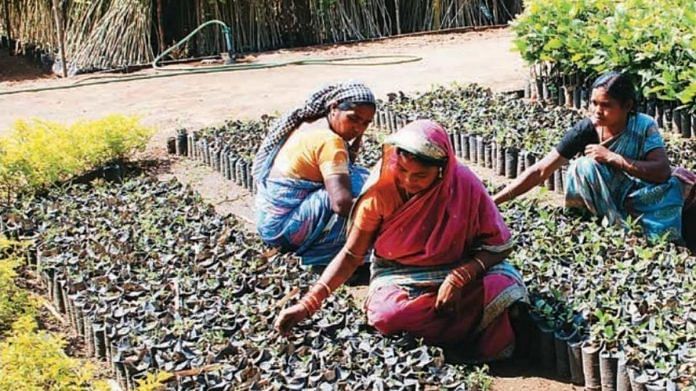New Delhi: As the Modi government prepares the Union Budget for 2021-22 — expected to be its most difficult given the impact of the pandemic on the economy — one of the most closely watched allocations will be to the flagship rural job guarantee scheme, the Mahatma Gandhi National Rural Employment Guarantee Act (MGNREGA).
MGNREGA, which promises 100 days of employment each year to every rural household in demand of work, has seen a steady increase in its budget allotment ever since its introduction by the UPA-I government in February 2006.
The scheme was allotted Rs 61,500 crore in the last Union Budget. But, as the government battled the harsh impact of the pandemic that led to job losses and also forced migrant workers to return home, the rural distress scheme was given an additional allocation of Rs 40,000 crore, taking the total amount to a massive Rs 1 lakh crore.
According to officials in the Ministry of Rural Development, which oversees the scheme, an 18 per cent increase from Rs 61,500 crore in the current fiscal has been demanded in the annual budgetary allocation for 2021-22.
However, since the scheme already got a big boost in view of the pandemic, ministry officials said they can expect a leaner increase of around 10 per cent.
ThePrint reached Rohit Kumar, Joint Secretary in-charge of MGNREGA in the rural development ministry, for comment but he declined.
Also read: Aadhaar, MGNREGA, DBT, rural housing — how Modi has hijacked Congress legacy
The status
With migrants returning home amid the pandemic and the lockdown that lasted nearly three months, MGNREGA was expected to act as a cushion to soften the blow.
Thus, even before the half-way mark in the 2020 financial year, around Rs 64,000 crore had already been spent on the scheme due to the impact of reverse migration.
This trend continues. According to rural development ministry data, an expenditure of Rs 86,933 crore has already been incurred on MGNREGA in 2020-21 so far, up from Rs 68,261 crore last year and Rs 69,681 crore in 2018-19.
The data also showed that 313 crore man-days have been generated under the scheme so far already, up from 265 crore in the previous fiscal, a rise of around 18 per cent. This, when the figures for the full fiscal are yet to be established, and are bound to show a wider gap.
A total of 6.96 crore households have already got work under the scheme till date this fiscal year, up from 5.48 crore in FY 2019-20, 5.27 crore in 2018-19 and 5.12 crore in 2017-18.
The ministry has been under pressure from several states to advocate a big increase in MGNREGA allocation for the next financial year as funds for most states have dried up in the second quarter of 2020 itself due to high demand in wake of the pandemic.
Funds for MGNREGA are released in accordance with the labour budget of the states, which usually gets approved in December of the previous year. Due to this, the budget did not anticipate the Covid-19 crisis and spike in job demand, which has led to a negative balance in the second quarter of MGNREGA funds for many states, said ministry officials.
In states such as Andhra Pradesh, Telangana and Bihar, for instance, the governments have been forced to overdraw to the tune of Rs 1,083 crore, Rs 616 crore and Rs 749 crore, respectively.
However, the Act mandates that the government provide 100 days of work to every rural household that demands work and, hence, legally, funds have to be made available accordingly. The allocation for it, therefore, is largely an indication.
Also read: This is how Modi govt plans to help MGNREGA workers during Covid-19 lockdown
The political significance
MGNREGA has been a politically crucial scheme, a fact reflected in the rising budget allotted to it even after the BJP-led National Democratic Alliance government came to power in 2014.
While Prime Minister Narendra Modi termed it a “living monument of the UPA’s failures” in Parliament in 2015, his government has been laying special emphasis on the scheme, both in terms of funding as well as removing glitches in its implementation.
The Congress has attacked the PM for his remarks against the scheme and pointed out how its increased allocation exposes that claim.
The funds for MGNREGA have gone up from around Rs 11,000 crore in 2006-07 to Rs 40,000 crore in 2009-10, Rs 48,000 crore in 2017-18, Rs 60,000 crore in 2019-20 and to Rs 1 lakh crore now.
MGNREGA has been a politically sensitive issue not just between rival parties, but also within governments.
For instance, in 2013 when the then Finance Minister P. Chidambaram slashed the funds for MGNREGA, then Rural Development Minister Jairam Ramesh shot off a letter to Manmohan Singh, who was the prime minister, protesting against the “savage cuts”.
The Modi government has also flirted with the idea of an urban version of MGNREGA — a concept that was informally talked about even during UPA rule when C.P. Joshi and Vilasrao Deshmukh were rural development ministers.
During the lockdown, the housing and urban affairs ministry had held meetings with states to deliberate on a scheme for assured employment generation on the lines of MGNREGA in small urban centres with a population of 1 lakh, but dropped the idea owing to shortage of funds.
Also read: What an ‘urban NREGA’ should look like



